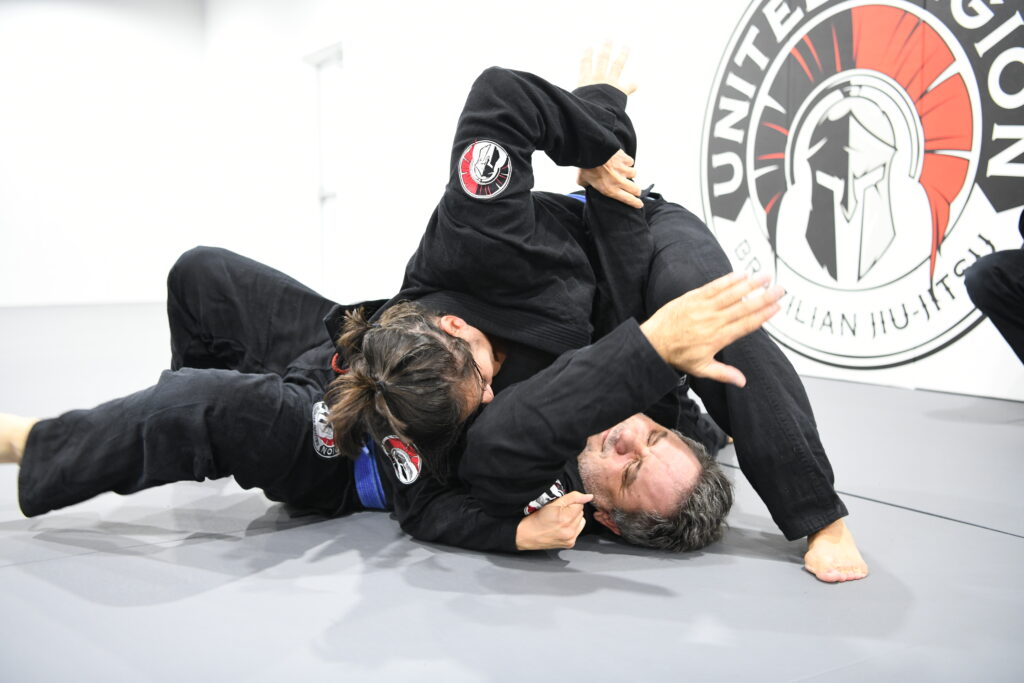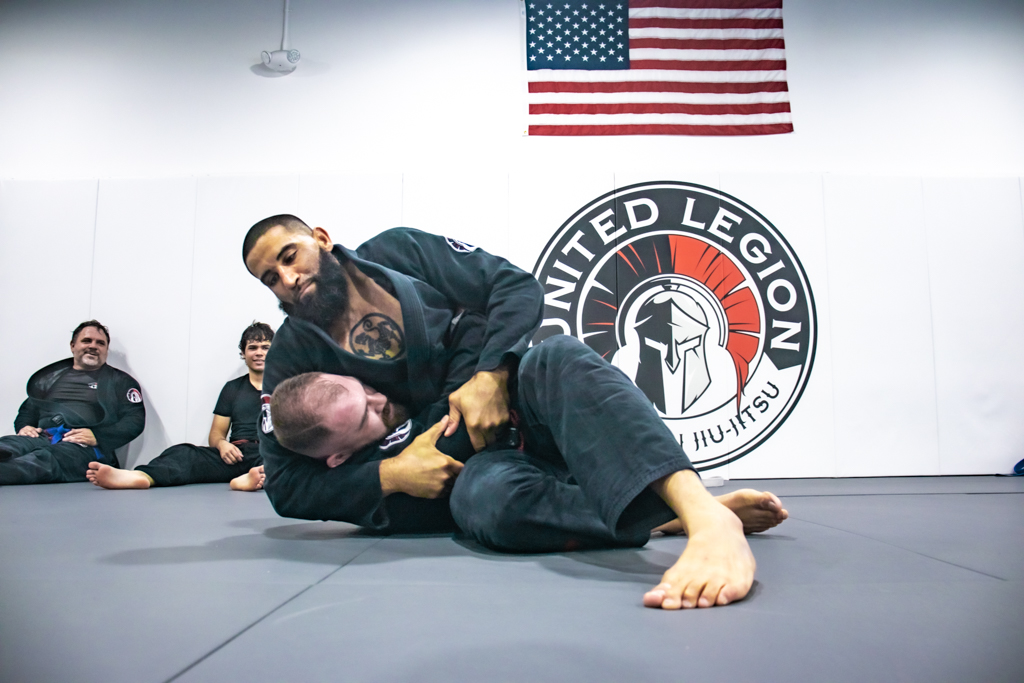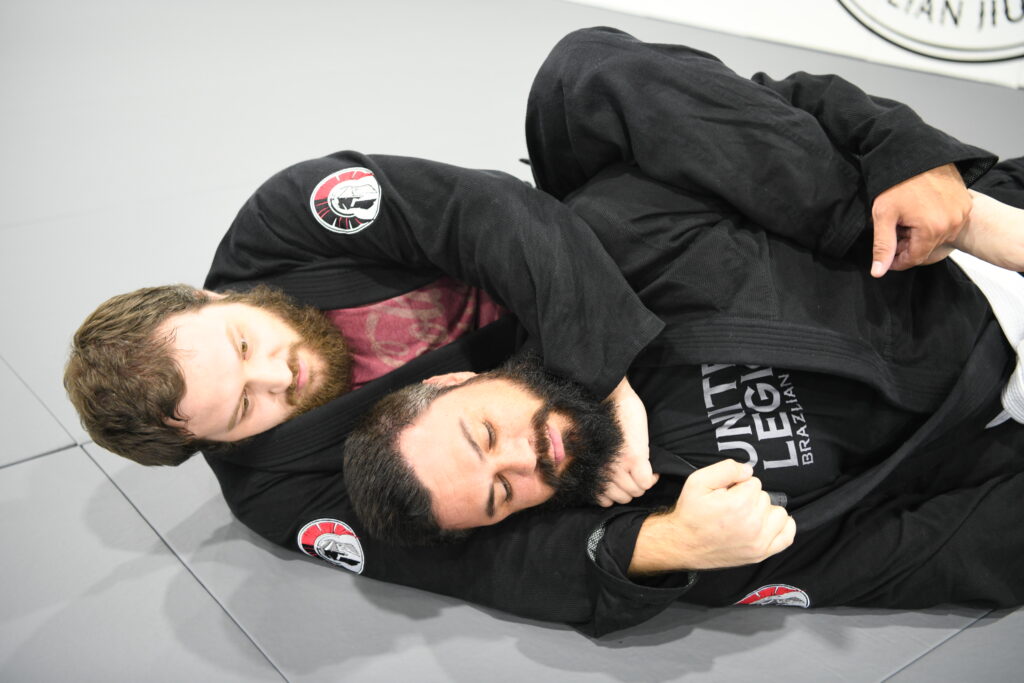SELF-DEFENSE
JIU-JITSU APPLICATION
One of the primary fears in a real situation is to end up on the ground pinned beneath a larger opponent. Brazilian Jiu-Jitsu gives you the tools to prevail in such a scenario, especially from the bottom position. Therefore, BJJ is one of the best forms of self-defense.
Generally, Jiu-Jitsu can be used in four areas:
- Self-defense
- Gi competition
- No-Gi competition
- Mixed Martial Arts (MMA)
Of these four applications, we focus on the first area by answering the question, “How would one use Jiu-Jitsu in real life?” Also, we don’t distinguish BJJ from self-defense as we do not consider it to be a sport. BJJ is one of many martial art styles a person can use to defend themselves or their loved ones.
DIFFERENCE IN MARTIAL ART STYLES
In the realm of unarmed self-defense there are two main categories: striking and grappling. Common striking arts include the various styles of Kung Fu, Boxing, Muay Thai, Savat, Tae Kwon Do, Karate, and Krav Maga.
In contrast, the grappling arts include Freestyle and Greco-Roman Wrestling, Catch Wrestling, Judo, Sambo, and Brazilian Jiu-Jitsu.
Not surprisingly, the highest form of fighting is MMA: the blend of striking and grappling arts to form a complete style. For a beginner, however, it’s best to start learning and mastering one martial art. Since it requires the least athleticism, BJJ is a popular choice. It’s difficult to become great at many things simultaneously.
By focusing on one thing at a time, we don’t scatter our energy in multiple directions, becoming the jack of all trades but a master of none. Master ground fighting and you’ll be prepared for 90% of real-world altercations.

SELF-DEFENSE STARTS WITH BJJ
In a typical BJJ class, we cover a mix of the following:
- Takedowns
- Headlocks
- Bear hugs
- Ground pins
- Wrist grabs
- Wall fighting
- Chokes and joint locks
- Ground fighting
- 2-on-1 drills
The variables of what could happen in a real scenario are virtually infinite. Noted above, though, are common themes one might encounter in day-to-day life. These situations can escalate quickly when an opponent is heavier or stronger than you.
Bear hugs, wrist grabs, and headlocks can all become problematic very quickly without knowing how to break these holds.
A COMMON PROBLEM IN MARTIAL ARTS
A frequent weakness of many martial arts is that they claim their style has supposed deadly, lethal, or devastating techniques. In the past, “grand masters” asserted they had the secret knowledge of Dim Mak: the death touch.
The problem with these claims is that if an instructor had the knowledge of Dim Mak and used it in training, such practice would result in someone’s death. The logical conclusion, then, is that a student of those “grand masters” can’t be confident—unless they’re willing to take a life—that those techniques actually work.
The solution
The only way a martial artist can be sure of a technique’s efficacy is to test it on a resisting opponent. This is one of the key distinctions that separates Brazilian Jiu-Jitsu from almost all other martial arts; You can practice the techniques of BJJ—takedowns, wrestling, and submissions—with full force against a resisting opponent without lethal consequences.
Once a student is successful at employing his techniques against resisting training partners, he’s able to defend himself in real-life encounters.
Another point to remember is that almost all altercations will end up on the ground. This is especially dangerous if the opponent is larger than you or has more street fighting experience. If you understand the basics of BJJ, you’ll be equipped with sufficient tools to handle most unarmed opponents.

SUMMARY—WHY LEARN SELF-DEFENSE?
Self-defense is a life skill.
You never know when or where you’ll have to defend yourself. You may not be able to contact law enforcement. With a solid grasp Jiu-Jitsu, you’ll increase your ability to recognize and respond to dangerous situations. Although no amount of martial arts training will make you invincible, consistent training will increase your probability of successfully defending yourself.
Jiu-Jitsu for self-defense.
A common question many beginners have is, “What’s the difference between self-defense and Jiu-Jitsu?” In essence, there’s no difference. Self-defense is not a distinct art. The various arts are simply different ways to achieve the same goal: self-protection. The more appropriate question is, “What do you prefer to learn?” In our view, Jiu-Jitsu is the best place to start because almost all real altercations will end up on the ground. If you don’t know how get heavier opponent off of you, you’re swimming with sharks.
Real World Application.
Jiu-Jitsu is one of the few martial arts that you can be confident will work in the real world. The problem with many martial arts is that they lead the student to believe that they’re learning supposedly devastating strikes. In truth, very few martial arts actually allow or encourage the student to practice against a fully resisting opponent. For that reason BJJ is a superior martial art because in every round of grappling, you’re required to test your techniques against a training partner who is resisting.
If you would like to try a few self-defense classes in Altamonte Springs, click the button below and send us your contact information. We’ll reach out to you within one business day.

To try a few classes, click below!